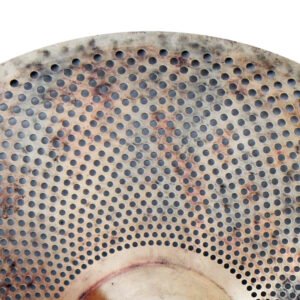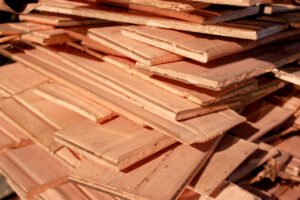When you’re watching a jazz drummer create intricate patterns on a 22-inch ride while occasionally punctuating phrases with a bright 16-inch crash, you’re witnessing two distinctly different cymbals at work. While they’re both essential components of a drummer’s setup, crash and ride cymbals serve fundamentally different purposes in your musical arsenal. Their unique construction, playing techniques, and sonic characteristics make them specialized tools that can’t simply be interchanged.
Key Takeaways
Crash and ride cymbals serve different functions: crashes create accents and explosions, while rides maintain consistent rhythmic patterns.
Physical differences exist in size and weight: crashes are 14-18 inches and lighter, while rides are 20-22 inches and heavier.
Thickness varies significantly: crashes are thinner (1.4-2.0mm) for quick response, while rides are thicker (2.2-3.0mm) for better articulation.
Playing techniques differ: crashes require glancing edge strikes, while rides use stick-tip hits on the bow or bell.
Sound characteristics contrast: crashes have quick decay (3-4 seconds), while rides provide sustained resonance (6-8 seconds or longer).
Understanding the Basics of Crash and Ride Cymbals
Cymbals are essential components of any drum kit, with crash and ride cymbals serving distinct musical purposes. When exploring crash cymbal basics, you’ll find they’re typically thinner, ranging from 14 to 20 inches in diameter, and designed to produce quick, explosive accents. They’re mounted loosely to allow maximum vibration and decay, creating that characteristic “crash” sound when struck.
Ride cymbal essentials differ greatly in their construction and application. You’ll notice they’re generally thicker and larger, usually 20 to 22 inches in diameter, with a more pronounced bell. Their design focuses on articulation and sustain, allowing you to maintain consistent rhythmic patterns. The ride’s weight distribution creates distinct zones – the bow, edge, and bell – each producing unique tonal characteristics. While crash cymbals cut through the mix with bright, aggressive accents, rides provide the foundational rhythmic texture that drives the groove.
Physical Design and Construction Differences

You’ll notice immediate physical differences between crash and ride cymbals in their dimensions, with crashes typically measuring 14-18 inches and rides measuring 20-22 inches in diameter. Ride cymbals feature substantially thicker metal construction, often 2.2mm to 3.0mm at the bell, compared to crash cymbals which usually range from 1.4mm to 2.0mm. The metal composition also differs, with rides commonly using B20 bronze (80% copper, 20% tin) for articulation and durability, while crashes may incorporate B8 bronze (92% copper, 8% tin) for faster response.
Size and Weight Variances
Although both types belong to the cymbal family, crash and ride cymbals exhibit distinct physical differences in their size and weight specifications. You’ll find crash cymbals typically ranging from 14 to 18 inches in diameter, while ride cymbals are larger, measuring between 20 to 24 inches. This size ratio difference directly impacts their functionality and sound characteristics.
When examining weight distribution, you’ll notice that ride cymbals are considerably heavier, often weighing between 4 to 7 pounds. Crash cymbals, in contrast, are noticeably lighter at 1.5 to 3 pounds. The weight disparity results from the varying thicknesses across their surfaces – rides maintain a more uniform thickness throughout, while crashes feature a gradual taper from the bell to the edge, enabling their characteristic quick response and decay.
Metal Thickness and Alloys
The construction methods for crash and ride cymbals involve distinct metallurgical approaches and thickness profiles. You’ll find that rides are typically crafted with thicker metal (2.2-3.0mm) compared to crashes (1.4-2.0mm), which allows them to withstand sustained playing while maintaining their fundamental tone.
| Feature | Crash Cymbal | Ride Cymbal |
|---|---|---|
| Metal Thickness | 1.4-2.0mm | 2.2-3.0mm |
| Common Alloy | B8 Bronze | B20 Bronze |
| Core Metals | 92% Cu, 8% Sn | 80% Cu, 20% Sn |
| Heat Treatment | Rapid cooling | Gradual tempering |
The alloy composition notably affects each cymbal’s sonic characteristics. Crashes often use B8 bronze for quick response and bright attack, while rides frequently feature B20 bronze for complex overtones and superior projection. The manufacturing process includes specific heat treatments that further differentiate their tonal properties.
Sound Characteristics and Tonal Properties
You’ll hear crash cymbals deliver a loud, explosive attack with a shorter decay time of 3-4 seconds, while ride cymbals project a more controlled attack with sustained resonance lasting 6-8 seconds or longer. Crashes typically occupy a higher frequency spectrum centered around 4-6kHz that cuts through the mix, whereas rides produce lower fundamental frequencies in the 2-4kHz range with complex overtones. The volume dynamics also differ greatly – crashes are designed for accent hits at peak volumes of 90-100dB, but rides maintain consistent articulation across varying velocities from 70-90dB during patterns and grooves.
Sustain and Decay Patterns
When comparing crash and ride cymbals’ sustain patterns, distinct differences emerge in their decay characteristics. You’ll notice that crash cymbals exhibit a rapid attack followed by a quick decay, typically lasting 2-4 seconds before fading completely. Their sustain characteristics feature a pronounced initial burst that quickly diminishes in volume and intensity.
Ride cymbals, in contrast, display longer sustain patterns that can extend up to 8-10 seconds. Their decay behaviors are more controlled and gradual, maintaining a consistent resonance throughout the sustain phase. You’ll find that rides produce a more stable wash of sound that slowly tapers off, rather than the explosive burst and quick fade of crashes. This extended sustain makes rides ideal for maintaining continuous rhythmic patterns.
Frequency Range Differences
Despite sharing similar materials and construction, crash and ride cymbals produce markedly different frequency ranges that shape their distinct tonal characteristics. You’ll find that crash cymbals typically occupy the mid to high-frequency spectrum, with their fundamental frequencies ranging from 200 Hz to 8 kHz. They’re designed to cut through the mix with explosive, bright overtones.
In contrast, ride cymbals dominate the mid-frequency range, usually between 150 Hz and 5 kHz, with more complex harmonic content. When you strike a ride, you’ll hear a fuller, more controlled spread of frequencies that emphasizes the stick definition. The sound dynamics of rides feature prominent fundamental tones and articulate mid-frequencies, while crashes project more pronounced high-frequency content that creates their characteristic splash and decay.
Attack and Volume Level
The attack and volume characteristics between crash and ride cymbals represent another key sonic distinction. You’ll find that crash cymbals deliver an immediate, explosive attack with a rapid volume spike, making them ideal for accents and punctuation. Their attack dynamics are characterized by a quick build-up and fast decay.
Ride cymbals, in contrast, offer superior volume control with a more gradual attack profile. When you strike a ride, it produces a controlled, articulate sound that builds more slowly and sustains longer. This allows you to maintain consistent patterns and execute subtle dynamic variations. The ride’s balanced attack characteristics make it versatile for both delicate patterns and driving rhythms, while crash cymbals excel at providing dramatic, high-volume impacts in musical passages.
Playing Techniques for Each Cymbal Type
Playing techniques differ markedly between crash and ride cymbals due to their distinct acoustic properties and musical roles. Your stroke techniques need to adapt to extract the best sound from each type.
| Technique | Crash Cymbal | Ride Cymbal |
|---|---|---|
| Basic Hit | Glancing blow at 45° angle | Tip of stick on bow |
| Sound Zone | Edge to mid-bow area | Bell, bow, or edge |
| Dynamics | Quick, explosive strokes | Controlled, consistent hits |
| Stick Choice | Medium to heavy sticks | Light to medium sticks |
You’ll want to strike a crash with a sweeping motion to activate its full frequency range. For rides, you’ll maintain precise control using the stick’s tip, focusing on articulation points. When playing styles demand it, you can crash a ride cymbal, but you shouldn’t regularly ride a crash cymbal as it won’t provide the necessary definition. Your bell playing on rides requires a distinct vertical stroke, while edge work needs angled approaches for both types.
Common Uses in Different Musical Genres
Musical genres shape how you’ll deploy crash and ride cymbals within your drum arrangements. Rock preferences typically demand aggressive crash accents and driving ride patterns, while jazz dynamics call for nuanced cymbal work that flows with the ensemble.
In metal and hard rock, you’ll often use multiple crash cymbals for powerful accents and dramatic endings, with the ride cymbal maintaining intense patterns during verses
Jazz arrangements favor sophisticated ride cymbal patterns with subtle crash accents, emphasizing the “ting-ting-ta” rhythm on the ride’s bow
Funk music relies on crisp ride patterns with strategic crash punctuations to accent syncopated grooves
Blues drummers generally prefer minimal crash usage while focusing on ride cymbal swing patterns
Modern pop productions often blend both cymbals’ characteristics, using crashes for chorus impacts and rides for verse groove development
Each genre’s unique requirements will dictate your cymbal selection and playing approach, making versatility in technique essential for cross-genre performance.
Choosing Between Crash and Ride Cymbals
When selecting between crash and ride cymbals, you’ll need to evaluate several critical factors that affect your overall sound and playability. Consider the cymbal’s weight, as heavier cymbals generally produce longer sustain and more defined articulation. Ride cymbals typically range from 20-22 inches and feature a more pronounced bell, making them ideal for maintaining steady rhythmic patterns. Crash cymbals, usually 14-18 inches, deliver quick, explosive accents with faster decay.
Assess your playing style and genre requirements. If you’re focusing on jazz or fusion, you’ll want a ride cymbal with clear stick definition and complex overtones. For rock or metal, consider a heavier crash cymbal that can cut through high-volume situations. Pay attention to the cymbal’s profile – lower profiles offer faster response while higher profiles provide more projection and wash. Test the bell sounds, as they’ll greatly impact your versatility during performances.
Conclusion
While you’ll find that crash and ride cymbals are both essential voices in your percussive arsenal, they’re as different as lightning and thunder. Your crash’s explosive burst cuts through like a flash, while your ride’s sustained wash rolls like distant thunder. Understanding their distinct physical properties, tonal characteristics, and playing techniques will guarantee you’re maximizing each cymbal’s unique sonic potential in your musical journey.



